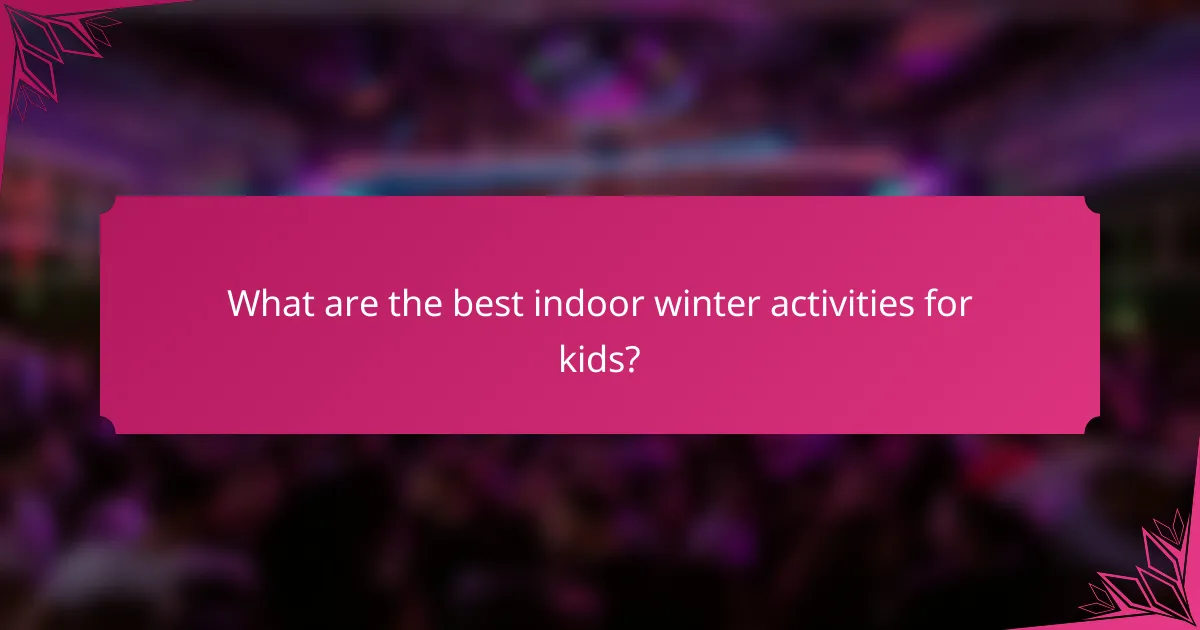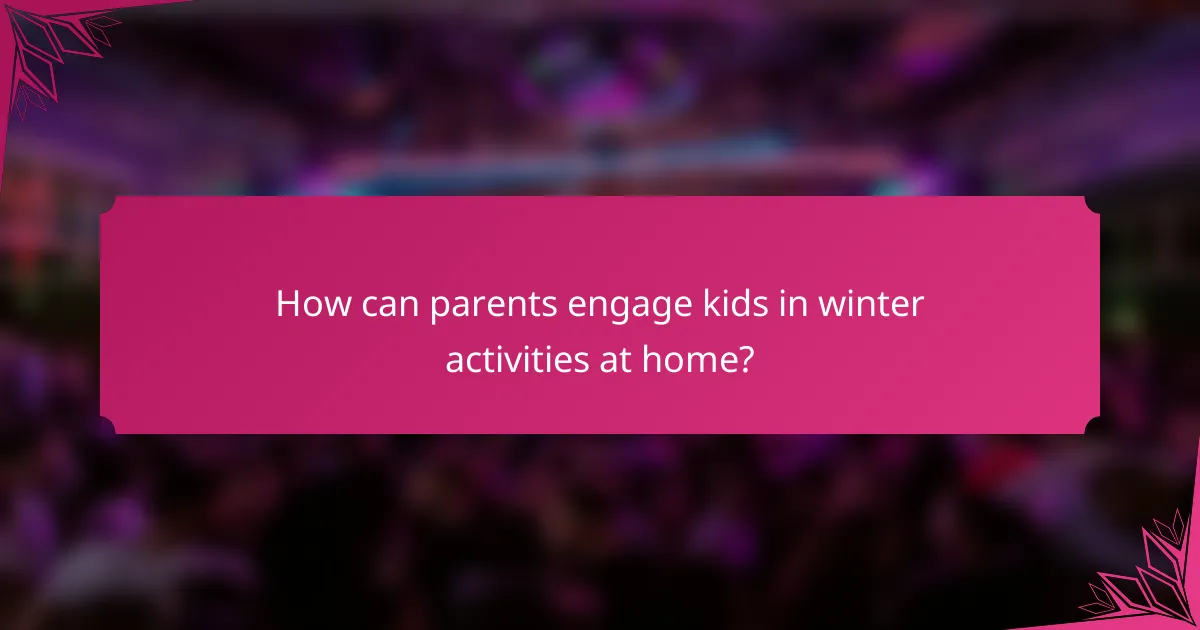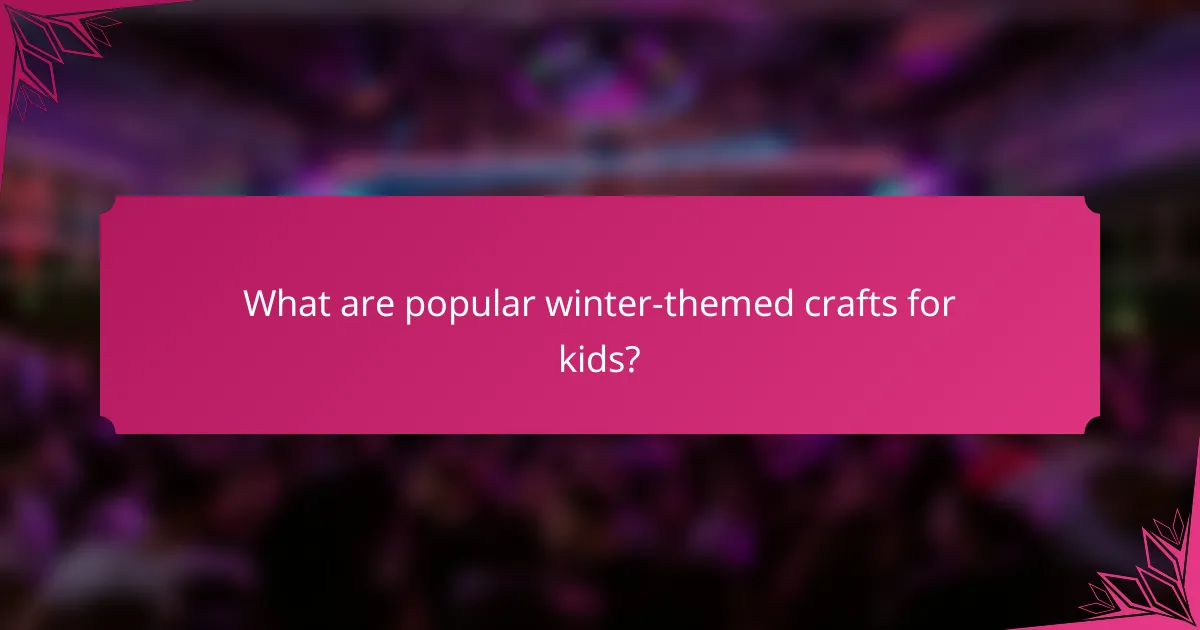Winter can be a wonderful time for kids to explore fun activities that spark their creativity and keep them engaged. From indoor projects that require minimal resources to exciting outdoor adventures in the snow, there are plenty of ways to make the most of the colder months. By planning structured days filled with both indoor and outdoor play, parents can ensure their children stay active and entertained all winter long.

What are the best indoor winter activities for kids?
The best indoor winter activities for kids include engaging projects that stimulate creativity and learning while keeping them entertained. These activities can be easily set up at home and require minimal resources, making them perfect for chilly days.
Arts and crafts projects
Arts and crafts projects are a fantastic way for kids to express their creativity during winter. Simple materials like paper, glue, and colors can be transformed into unique creations, such as homemade cards or decorations. Consider setting up a themed craft day where kids can create winter scenes or holiday ornaments.
To enhance the experience, provide a variety of supplies, including recycled items, and encourage kids to use their imagination. This not only fosters creativity but also helps develop fine motor skills.
Indoor scavenger hunts
Indoor scavenger hunts are exciting and can be tailored to fit any theme or age group. Create a list of items for kids to find around the house, such as a specific toy, a book, or a kitchen utensil. You can make it more challenging by providing riddles or clues for each item.
Set a timer to add an element of competition, and consider offering small prizes for the winners. This activity promotes problem-solving skills and keeps kids active even when they are indoors.
Cooking and baking sessions
Cooking and baking sessions are not only fun but also educational for kids. Involve them in preparing simple recipes, such as cookies or homemade pizza, where they can learn about measurements and ingredients. This hands-on experience can spark an interest in culinary skills.
Ensure safety by assigning age-appropriate tasks and supervising closely, especially when using sharp tools or hot appliances. Encourage kids to decorate their creations, making the process even more enjoyable.
Board games and puzzles
Board games and puzzles provide excellent opportunities for family bonding during winter. Choose games that suit the age and skill levels of your kids, ensuring everyone can participate. Classics like Monopoly or Scrabble can be great for older children, while younger kids might enjoy simpler games like Candy Land.
Puzzles are also a great option, as they can be completed individually or as a group. This activity enhances critical thinking and patience, making it both fun and educational.
DIY science experiments
DIY science experiments can captivate kids’ curiosity and encourage a love for learning. Simple experiments, such as creating a volcano with baking soda and vinegar or making slime, can be done with household items. These activities can be both entertaining and informative, teaching kids about chemical reactions and properties of materials.
Always supervise experiments and discuss the science behind them to enhance understanding. Consider documenting the experiments with photos or a journal to track progress and results, adding an educational layer to the fun.

How can parents engage kids in winter activities at home?
Parents can engage kids in winter activities at home by planning structured, fun-filled days that incorporate both indoor and outdoor play. Emphasizing creativity and learning through play can keep children entertained and active during the colder months.
Creating a winter activity schedule
Establishing a winter activity schedule helps maintain structure while ensuring kids have a variety of engaging experiences. Aim for a mix of physical activities, crafts, and educational games, dedicating specific days to each type of activity.
Consider setting aside time each week for outdoor play, such as building snowmen or ice skating, alongside indoor activities like baking or arts and crafts. A simple weekly planner can help keep track of these activities and ensure a balanced approach.
Setting up themed activity days
Themed activity days can make winter more exciting and engaging for kids. Choose themes like “Winter Wonderland” for snow-themed crafts and games, or “Cozy Indoor Day” for baking and movie marathons.
For example, on a “Winter Wonderland” day, you could have kids create snowflakes from paper, make hot cocoa, and watch winter-themed movies. This approach not only fosters creativity but also allows for family bonding through shared experiences.
Using online resources for ideas
Online resources are abundant and can provide fresh ideas for winter activities. Websites dedicated to parenting, education, and crafts often feature seasonal activities that are easy to implement at home.
Look for blogs, Pinterest boards, or educational platforms that offer step-by-step guides and printable materials. Utilizing these resources can save time and inspire new projects, ensuring that kids remain engaged throughout the winter months.

What are fun winter outdoor activities for kids?
Fun winter outdoor activities for kids include engaging in playful experiences that take advantage of snow and cold weather. These activities not only promote physical fitness but also encourage creativity and teamwork.
Building snowmen and snow forts
Building snowmen and snow forts is a classic winter activity that sparks creativity and teamwork. Kids can use snow to create various shapes and structures, enhancing their imaginative play. To build a snowman, start by rolling large snowballs and stacking them, then add accessories like scarves and hats.
When constructing snow forts, ensure the snow is packed tightly for stability. Encourage kids to work together to design their fort, which can serve as a base for snowball fights or simply a cozy winter hideout.
Winter sports like skiing and snowboarding
Winter sports such as skiing and snowboarding offer thrilling experiences for kids who enjoy adventure. Many ski resorts provide lessons for beginners, making it accessible for children of various skill levels. It’s essential to choose appropriate gear, including helmets and warm clothing, to ensure safety and comfort.
Parents should consider local ski areas that cater to families, often featuring beginner slopes and child-friendly facilities. Look for packages that include rentals and lessons to make the experience more affordable and convenient.
Nature walks and winter hikes
Nature walks and winter hikes allow kids to explore the beauty of winter landscapes while staying active. These outings can be as simple as walking through local parks or venturing into nearby nature reserves. Dress in layers to keep warm and ensure everyone has appropriate footwear for snowy or icy conditions.
During these hikes, encourage kids to observe wildlife and track animal footprints in the snow. This not only makes the experience educational but also fosters a deeper appreciation for nature during the winter months.

What are the benefits of indoor activities during winter?
Indoor activities during winter provide essential benefits such as mental stimulation, social interaction, and physical exercise. Engaging in these activities can help combat the winter blues while fostering creativity and family connections.
Promotes creativity and imagination
Indoor activities encourage children to explore their creativity and imagination in various ways. Craft projects, storytelling, and role-playing games allow kids to express themselves and think outside the box. Simple materials like paper, colors, and household items can be transformed into art, enhancing their creative skills.
Consider setting up a designated craft corner at home where children can freely create. Regularly rotating supplies can keep their interest alive and inspire new ideas.
Encourages family bonding
Participating in indoor activities together fosters stronger family bonds. Board games, cooking, and collaborative projects provide opportunities for parents and children to connect and communicate. These shared experiences can create lasting memories and improve family dynamics.
Try scheduling a weekly family night dedicated to games or cooking. This routine can help everyone look forward to quality time together, strengthening relationships.
Provides physical activity
Indoor activities can also incorporate physical movement, which is vital during the winter months when outdoor play may be limited. Activities like dancing, yoga, or indoor obstacle courses can keep children active and healthy. Even simple games like hide-and-seek can promote movement and fun.
To ensure kids get enough exercise, aim for at least 30 minutes of physical activity each day. You can use online videos for guided workouts or create a fun dance-off to keep things exciting.

How to choose the right winter activities for different age groups?
Selecting winter activities for kids involves understanding their age-related abilities and interests. Tailoring activities to their developmental stage ensures engagement and safety, while considering their preferences enhances enjoyment.
Consider developmental stages
Different age groups have varying physical and cognitive abilities, which influence the types of winter activities suitable for them. For toddlers, simple activities like building snowmen or playing with snowballs are ideal, as they focus on basic motor skills and sensory experiences.
Preschoolers can handle slightly more complex tasks, such as sledding or participating in organized group games. School-aged children can engage in activities that require more coordination and teamwork, like ice skating or skiing, which also promote social interaction.
Assess interests and preferences
Understanding a child’s interests is crucial when selecting winter activities. Some kids may prefer active outdoor play, while others might enjoy creative indoor projects like crafting holiday decorations or baking seasonal treats.
Involve children in the decision-making process by discussing potential activities. This can help identify what excites them, whether it’s a snowball fight, a winter hike, or a cozy movie marathon. Balancing their interests with safety and feasibility will lead to a more enjoyable winter experience.

What are popular winter-themed crafts for kids?
Popular winter-themed crafts for kids include activities that celebrate the season’s beauty and festivities. These crafts often involve materials that are easily accessible and can be completed indoors, making them perfect for chilly days.
Snowflake Crafts
Snowflake crafts are a classic winter activity that can be both fun and educational. Kids can create snowflakes using paper, scissors, and markers, or even experiment with different materials like coffee filters or beads. This craft not only enhances fine motor skills but also allows for creativity as each snowflake can be uniquely designed.
To make snowflakes, start by folding a piece of paper into quarters and cutting out shapes along the edges. When unfolded, the result is a beautiful snowflake pattern. Consider using white paper for a traditional look or colored paper for a vibrant twist.
Winter Scene Dioramas
Creating winter scene dioramas is an engaging way for kids to explore their imagination. Using a shoebox or any small container, children can build a miniature winter landscape with cotton balls for snow, small figurines, and craft supplies. This activity encourages storytelling and artistic expression.
To create a diorama, gather materials like cardboard, glue, and decorative items such as glitter or sequins. Kids can depict scenes like a snowy forest or a cozy cabin, providing an opportunity to discuss winter themes and nature.
Holiday Ornaments
Making holiday ornaments is a delightful winter craft that can be enjoyed by children of all ages. Kids can use materials like felt, paper, or even recycled items to create unique decorations for the home or to give as gifts. This craft fosters creativity and can be a wonderful family bonding experience.
Simple ornament ideas include cutting shapes from felt and decorating them with beads or glitter, or using clear plastic ornaments that can be filled with festive items like fake snow or small toys. Encourage kids to personalize their ornaments with their names or the year.
